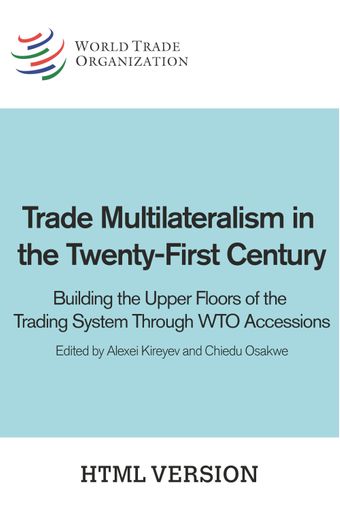WTO Rules, Accession Protocols and Mega-Regionals: Complementarity and Governance in the Rules-Based Global Economy

- Authors: Maša Lekic and Chiedu Osakwe
- Source: Trade Multilateralism in the 21st Century , pp 8-8
- Publication Date: enero 2017
- DOI: https://doi.org/10.30875/2af92efd-en
- Idioma: Inglés
Over the past twenty years, the rules-based global economy has been subject to a dynamic process of transformation. The trading environment has been characterized by shifts in the balance of economic power, emerging structures and rapid changes in global and regional alliances. Since its establishment in 1995, the WTO has sought to adapt to these global trends. The 2017 Trade Facilitation Agreement (TFA), the 2015 Nairobi Decisions on Agriculture, the 2015 expansion of the Information Technology Agreement (ITA) and twenty years of cumulative WTO accessions acquis are all part of this process of constant adaptation by the WTO to a rapidly changing environment. However, after the Seattle Ministerial meeting in 1999, free trade agreements (FTAs) and regional trade agreements (RTAs) mushroomed. The 'spaghetti-bowl’ consequences and the continuing proliferation of preferential trade agreements (PTAs) and counter-PTAs have created challenges and opportunities for the rules-based multilateral trading system. Several questions have been raised, revolving around the compatibility and the discriminatory and trade diversion effects of such agreements. Are these agreements building blocks or stumbling blocks for the multilateral trading system? Moreover, the emergence of mega-regional RTAs (MRTAs), in particular the Trans-Pacific Partnership (TPP), have called into question, in some quarters, the power and relevance of the WTO at large. This chapter examines the core question of whether mega-regionalism (and FTAs by implication) poses an existential risk to the multilateral trading system and argues that the answer is ‘no’. The negotiating results from FTAs, including in their mega-regional forms, and trade multilateralism can coexist in a constructive, healthy and competitive relationship and both are essential for the governance of the multipolar twenty-first-century global economy. To substantiate this conclusion, the chapter reviews the WTO accessions acquis and compares it to the provisions of the TPP, without pre-judging its future. The comparative analysis is conducted across several areas: market access; trade rules (bilateral/plurilateral/multilateral); trade negotiations as an instrument for domestic reforms; and discriminatory effects. The results of the analysis point to areas of significant complementarity and mutual supportiveness between WTO accession acquis and the TPP, and different degrees of trade liberalization in certain sectors. The accessions acquis demonstrates a process of mutually supportive coexistence between bilateral and plurilateral negotiations and the multilateral legal and policy framework of the WTO. The scope and quality of accession negotiations results are comparable to results from PTAs, including MRTAs, and go further to show greater robustness and durability.
-
From This Site
/content/books/9789287046789s007-c009dcterms_subject,pub_countryId-contentType:WorkingPaperSeries -contentType:Periodical -contentType:BookSeries -contentType:ReportSeries105


